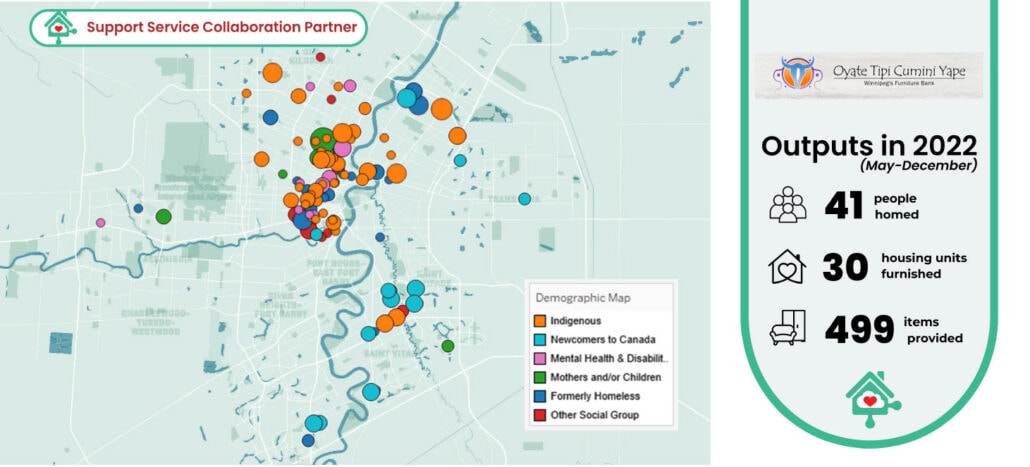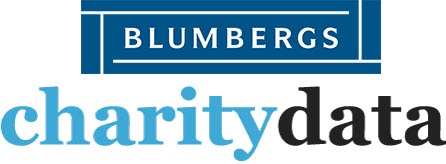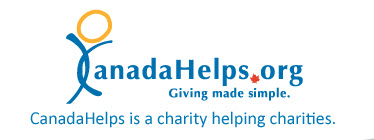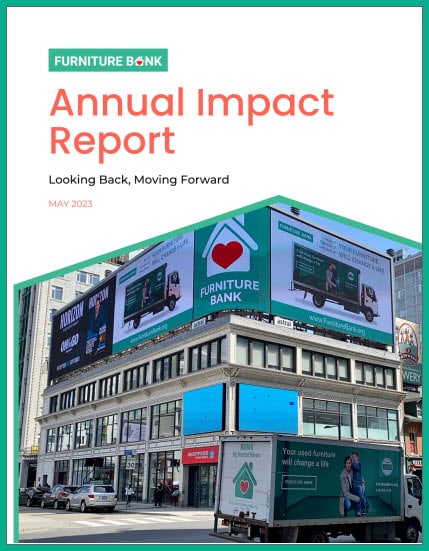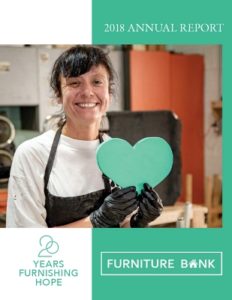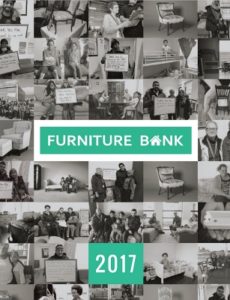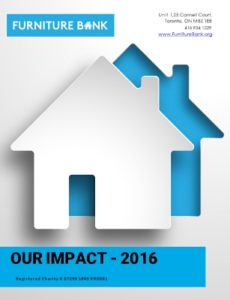Table of Contents

5 STAR RATING
Furniture Bank is a five-star, top 100 charity on Charity Intelligence’s website! The complete list of five-star charities is located on our website and can be found here.
The Problem
We have a problem in Canada
- 13% of Canadians have unmet housing needs and are experiencing chronic homelessness (StatsCan, 2020)
- That’s nearly 5 million people living in poverty or approximately 2 million families
- Over half a million Canadian households are living in social or affordable housing, with a waitlist of nearly 300,000
- When people living in poverty do find housing – they often have no beds to sleep on, places to sit at, desks to study at, or pots and pans to cook with
We can't ignore it any longer
- United Way estimates 116,000+ GTA individuals and families are struggling to put a roof over their heads
- Toronto is the poverty capital of Canada, with one in seven residents worried about the finances of having a roof over their head.
- Approximately 42,000 housing units are still needed to service real demand
- Our research shows each person moving into an empty apartment requires a minimum of $8,000 in available funds to turn empty housing into a furnished established home
We make an impact
- In 2022, Furniture Bank helped over 5,550 individuals and 2,500 families turn their empty house into a furnished home.
- Since we were founded, with your help and generosity, we have given over 127,147 individuals and their families a new start on life with the gift of a furnished home.
But we can do more
- We estimate there are 25,000 households that require our programs and service each year – let’s work together to ensure everyone has the dignity and comfort of a furnished home
Who is Furniture Bank?
Since 1998, Furniture Bank has matched unwanted furniture & homewares to individuals and families seeking to create a new home while transitioning out of homelessness or other forms of displacement. While Furniture Bank clients will have secured affordable housing, these families lack the assets to transform their new housing into a home. A person or a family without the financial means to make their housing into a home are said to live in Furniture Poverty.
Our mission and vision
Our vision
A Canada in which everyone has the stability and dignity of a furnished home.
Our mission
Our mission is to break the cycle of furniture poverty. Furniture Bank, a social enterprise-powered charity, transfers unwanted furniture and household goods donated by the community to people who are coming out of crisis. Our programs work in partnership with over 150 community agencies and shelters to assist people who are economically vulnerable including women and children leaving shelters, the formerly homeless, Indigenous, those struggling with mental health, LGBTQ+, BIPOC, newcomers and refugees who require furniture and household goods for their homes, a service that enhances both psychological and financial stability.
What is furniture poverty?
When someone doesn’t have the means to procure a bed, or a table, or a couch, or other home essentials, they are living in furniture poverty.
Without a bed, children sleep on piles of clothes on the floor.
Without a table, families eat their meals on milk crates.
Empty housing is not a home.
Furniture poverty has devastating effects on mental and physical health, and often results in people returning to crisis.
There are harmful physical, emotional, and financial consequences of furniture poverty.
Furniture poverty is a continuum:
- Furniture Insecurity: A household has the items they need for now. If something essential breaks or needs replacing, they do not have the means to do so. These households are often moving from one crisis to another.
- Furniture Destitution: Where a household has none or very few of the basic items needed. In a long-term, chronic situation.
Furniture Poverty affects too many low-income people in Canada, many of which are formerly homeless, women and children escaping abusive situations, and newcomer families and refugees.
How do we make an impact?
Our core areas of program operation are:
Furniture collection & delivery: Since 1998, Furniture Bank has matched reusable furniture & homewares to individuals and families seeking to create a new home while transitioning out of homelessness or other forms of displacement. This activity collects, processes and transfers over 50,000 items of furniture annually from the community which is matched and delivered to family’s empty housing units on demand.
"From my home to a new home in 72 hours - Furniture Bank's cycle time is incredible! Seeing Salesforce in use like this is deeply impactful for my team of volunteers today"
 Chris Morra, Salesforce Volunteer
Chris Morra, Salesforce Volunteer
The Workshop:
Our Indigenous-led Workshop trains participants in furniture repair, upholstery and woodworking. The mandate of Furniture Bank’s Workshop is to eliminate barriers in the attainment of meaningful work for equity-deserving people by providing trade training, creating long-term social employment opportunities, and providing sustainable careers in the refurbishing and reupholstering field. This in turn results in more quality furnishings for the beneficiary clients.
Since its inception in 2015, we have provided over 31 participants with opportunities to learn employable skills, and repaired and salvaged 18,606 items, ensuring furniture stays out of our landfills.
I love bringing the furniture back to life and making a family feel warm and cozy with their new gently used furniture pieces. I wanted to work in Finishing Carpentry and I couldn’t have been put in a better place. Giving me this opportunity has opened up my creative self, but also to learn how to run my own business.
 Melanie, Workshop employee
Melanie, Workshop employee
Our social employment programs:
Our Leg Up social hire program works with employment agencies and partners to provide work experience, life and skills training, and meaningful job opportunities to youth, newcomers to Canada and other individuals facing barriers to employment. Leg Up employees are embedded in all roles including positions within the warehouse, trucking, The Workshop, accounting, administration, family services and social enterprise. We train 35-40 participants annually, fostering personal and professional growth through job skills, emotional intelligence training, and financial literacy, providing skills and knowledge to achieve greater financial independence, and retain secure employment. Over the last decade have provided meaningful employment and skills development for over 350 employees.
Our trucking social enterprise provides professional removal and transportation of furniture donations, redistributing over 50,000 furniture items and serving over 2,500 families annually. All items selected by our clients are provided to them free of charge. Since our inception in 1998, we have given over 127,147 individuals and their families a new start on life through fully furnishing their homes.
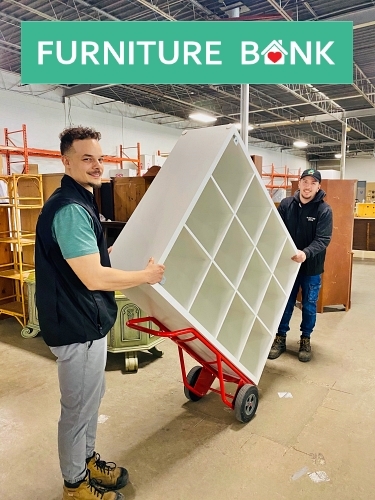
“I am incredibly grateful for the opportunity that Furniture Bank has given me by investing in my work ethic rather than my history, and providing me with the tools to develop career skills. It has been very rewarding being able to experience and contribute to the front line of client interaction, delivering to people in need and picking up donations from people who want to help. Being able to do that while being a part of an organization that is learning and growing has been nothing short of inspiring!”
 Tom, Leg Up employee
Tom, Leg Up employee
All of these services work together in alignment with our Theory of Change, which outlines how we’re driving impact to match our vision and informs the decisions we make around development and growth. More on how we developed our Theory of Change can be found via Innoweave’s case study on Furniture Bank.
Our Theory of Change
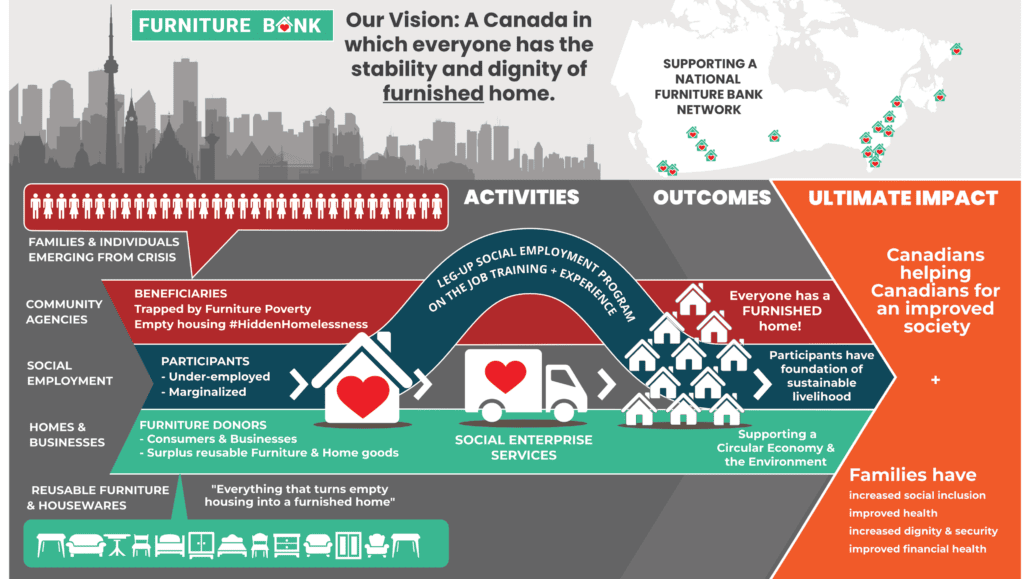
The model is composed of interconnecting stakeholders:
- Individuals and families in furniture poverty
- The agencies, community organizations, or shelters supporting these individuals.
- The social employment jobs within Furniture Bank to ‘deliver the mission’
- Canadian households and businesses
- Home furnishings and home goods able to be reused to address furniture poverty.
- Social enterprise services that address the needs of stakeholders above.
- The environment reducing landfill use through reuse and supporting a Circular Economy for business.
- Other furniture poverty reuse organizations connected into the Furniture Bank Network.
Where your donations go
We collect over 50,000 furniture items annually across the Greater Toronto Area. The 2,500 families we serve each year who receive furniture and home goods from us are transitioning out of homelessness, escaping abusive situations, and/or have recently arrived in Canada. We work with over 200 agencies to assist people who are economically vulnerable including women and children leaving shelters, the formerly homeless, Indigenous, those struggling with mental health, LGBTQ+, BIPOC, newcomers and refugees.
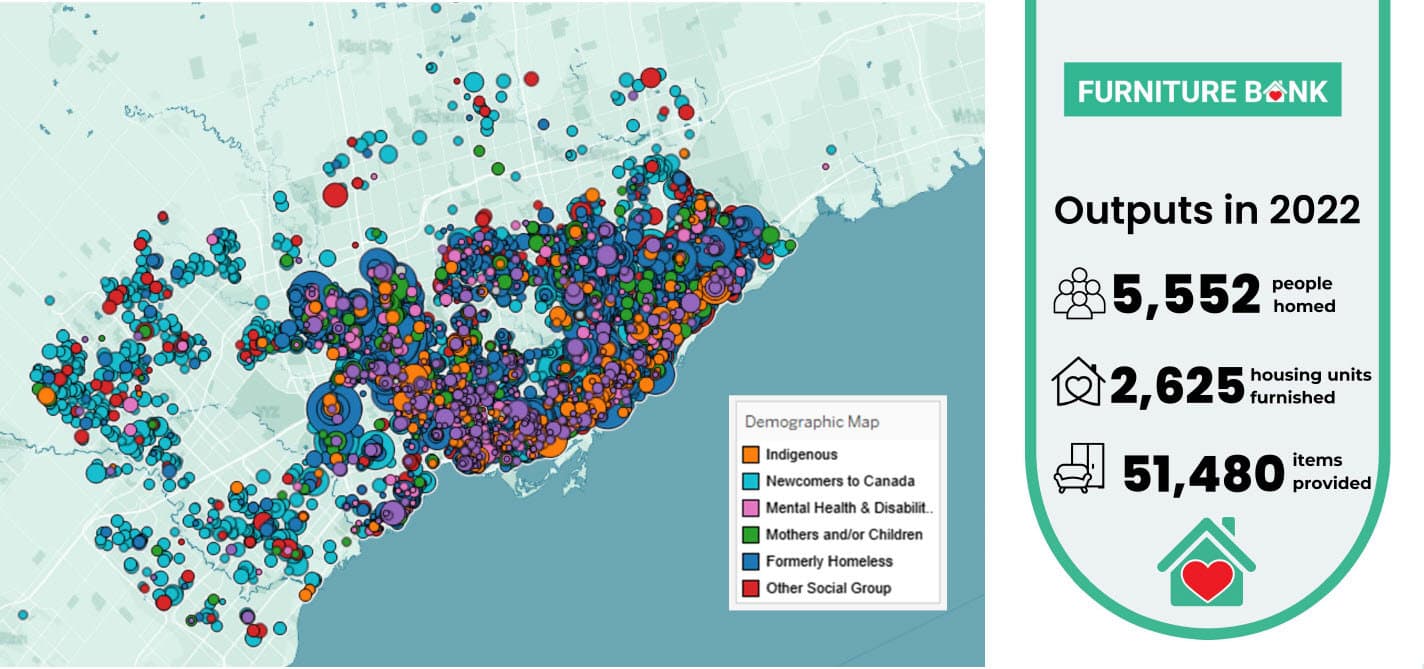
Beneficiaries supported

2020-2022 “The Pandemic Years” saw many community agencies that we traditionally supported close operations or move all their services to virtual. For those agencies that continued to make referrals, we continued to support them. However there is nothing virtual about furnishing a home – so the health and safety protocols put in place to protect volunteers, staff, donors and client beneficiaries put daily limits on our operations that reduced the capacity to support families during this time. Entering 2023 we have returned to our 2019 capacity levels.
OUR OUTPUTS
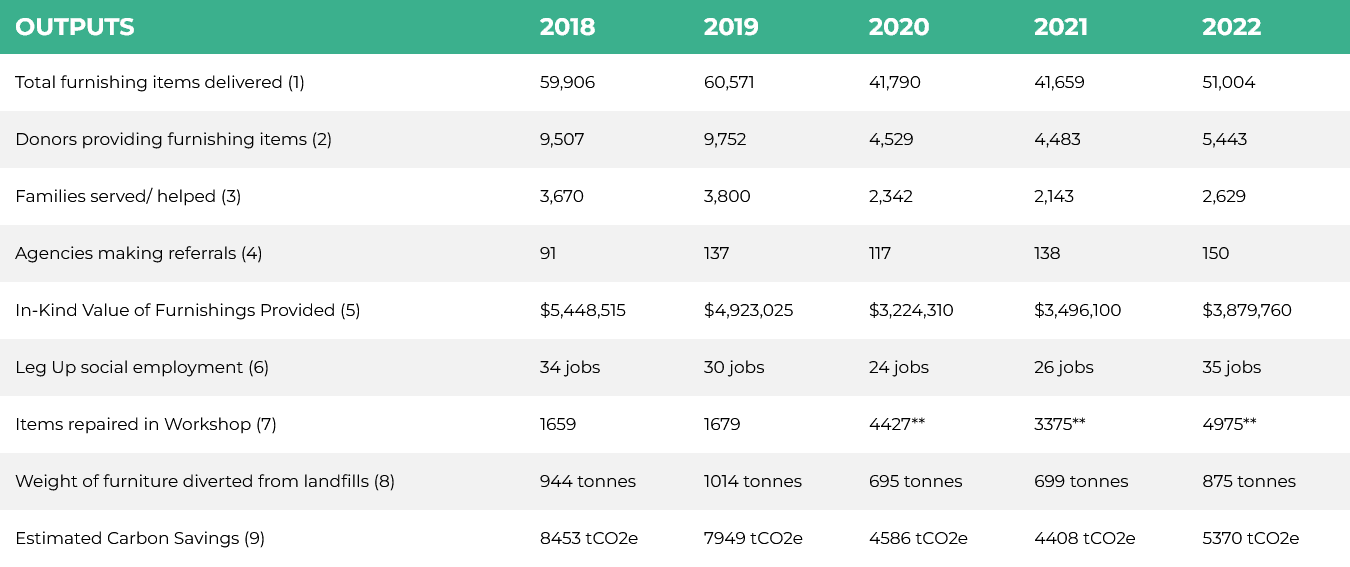
- Items and inventory tracked in Salesforce for each client family, confirmed delivery to final home.
- Unique households or businesses providing items for furnishing homes in Homing Program.
- Family is defined as unique family unit (could be family unit of 1 person or a family unit of 16 people). Average family size is 2.3 people per family.
- Total number of community agencies, shelters, and other social purpose groups providing support services for groups. This number represents the referrals from these agencies.
- Furniture Bank has a standardized grid of values of inkind values per items collected from donors. This is the total value.
- Our employment figure for the Leg Up program is comprised of those currently employed at Furniture Bank and those who have left Furniture Bank. during the period and role replaced.
- Includes assembled furniture from an IKEA donation.
OUR 2023 OUTPUT GOALS
Since we were founded in 1998, our ultimate goal has always been to help create a Canada in which everyone has access to a furnished home. That vision remains the same and acts as the north star for our team and the work we do. However, with over 50,000 Torontonians experiencing furniture poverty annually and 13% of Canadians having unmet housing needs, our focus is aimed at helping both locally and across Canada.
In the next 12 months, we will:
- Expand our national Support Services by welcoming 2 more new organizations onto our Furniture Bank platform.
- Increase the number of families served to 3,500 – a return to 2019 levels
- Maintain social job opportunities to 35 in our employment social enterprises (including our Workshop)
Our next 5 years goals include:
- Create the capacity within our existing facility to support 5,000 families as we explore 7-day-a-week operations.
- Expand the Workshop and increase the number of items repaired in the Workshop to 6,000 annually
- Add an additional 5 charity organizations onto our cloud-based impact platform and support an additional 2,000 families through this service.
- Begin assessing how social finance can support purchasing a larger facility and permanent home for Furniture Bank. This includes raising $2-3 million for the purchase.
Impact in their own words
Beneficiaries supported
"I woke up this morning as if I was in a dream. I still can’t believe this is my home and I get to live here – that my babies have an actual bed to sleep in. I don’t have to move anymore; I am home. God Bless you, for all that you do."
 Sarah, Furniture Bank Beneficiary
Sarah, Furniture Bank Beneficiary
Most of our families do not have access to furniture due to circumstances beyond their control and if it wasn’t for Furniture Bank they would not be able to resettle back into the community. This is a critical service for the most vulnerable in our society creating conditions for the good mental and physical health of our families. This week Furniture Bank provided and a sofa and sleep sets for a single mum and her son who previously had been sitting on garden chairs, and using clothing to nest on the floor
 Case Worker Focus Group
Case Worker Focus Group
With a furnished home my life has stability now. My self-confidence has grown and this has had a great impact in my professional and personal growth.
 Lucinda, Program Beneficiary
Lucinda, Program Beneficiary
OUR OUTCOMES
Our commitment to the Common Approach to Impact Measurement
The Common Approach to Impact Measurement is a set of measurement standards created for and governed by social purpose organizations[1]. These standards aim to provide a flexible and community-driven approach to measuring the impact of organizations working towards social and environmental goals.
The Common Approach to Impact Measurement has outlined five essential practices of good impact measurement[2]:
- Describe your intended change: Clearly articulate the changes you expect to occur as a result of your organization’s activities.
- Use indicators: Select appropriate indicators to measure the progress and impact of your organization’s activities.
- Collect useful information: Gather relevant data to assess the effectiveness of your organization’s activities in achieving the intended change.
- Gauge performance and impact: Analyze the collected data to evaluate the performance of your organization and the impact of its activities.
- Communicate and use results: Share the results of your impact measurement with stakeholders and use the findings to inform decision-making and improve your organization’s activities.
By following these essential practices, Furniture Bank can better understand and communicate their impact, make data-driven decisions, and improve their programs to achieve our mission.
Read more about Furniture Bank and the Common Approach here:
Social Return on Investment (SROI)
At Furniture Bank, we believe in transparency and accountability, ensuring that every dollar invested generates social, environmental, and economic value. To quantify the outcomes of our programs and help donors assess the scope and magnitude of our charity’s results, we employ the Social Return on Investment (SROI) concept, developed by Social Value International and Social Value Canada.
SROI is a robust method for measuring the social, economic, and environmental value created by an investment or organization. It transcends traditional financial statements, encompassing factors that are not typically expressed in monetary terms. Here are key points about the SROI concept as applied to Furniture Bank:
1. Measuring Value: SROI enables us to quantify the social and financial benefits and value of our services, programs, and organization to society. This approach helps us identify and evaluate the outcomes and impacts that go beyond mere financial returns.
2. Holistic Perspective: At Furniture Bank, we take a holistic approach by incorporating social, environmental, economic, and other values into our decision-making processes. This method allows us to reveal the economic value of our social and environmental outcomes, providing a comprehensive understanding of the benefits and profitability of our projects and initiatives.
3. Comparing Impacts: SROI involves identifying and valuing all the social and environmental impacts of our investments and comparing them to the financial returns. This comprehensive assessment allows us to understand the overall value we create through our endeavors.
4. Value for Money: SROI expands the concept of value for money by considering social and environmental outcomes alongside economic costs and benefits. This perspective empowers us to make better decisions and maximize the impact of our work by giving monetary values to these outcomes.
5. Principles and Process: Our SROI evaluation process identified those who are impacted by our work, finding evidence, evaluating results, calculating SROI, and interpreting and reporting the results. This collaborative effort ensures a comprehensive assessment of the value we generate.
6. Benefits and Challenges: Implementing SROI provides us with a framework to understand and communicate our social impact in financial terms. It fosters a mind-shift, viewing costs as investments with clear results benefiting the community. Note: This methodology can be costly and our dedication and effort to improve this model is linked to expansion funding.
At Furniture Bank, we are committed to demonstrating the meaningful outcomes of our initiatives using the SROI framework. This allows us to assess and communicate the broader value we create beyond financial returns. By employing the SROI concept, we provide donors and stakeholders with a clear understanding of the social, economic, and environmental impacts of their support, helping them make informed choices and contribute to maximizing positive outcomes for society.
Outcome Indicators, Proxies and Values for 2022
While we discuss discreate programs (Leg Up, Support Services and Workshop they are all integrated components of the larger and primary mission of Furniture Bank – HOMING. The SROI model was built to balance complexity and sustainability and does not attempt to separate SROI by program, rather all programs activities and outcomes are captured within the model.
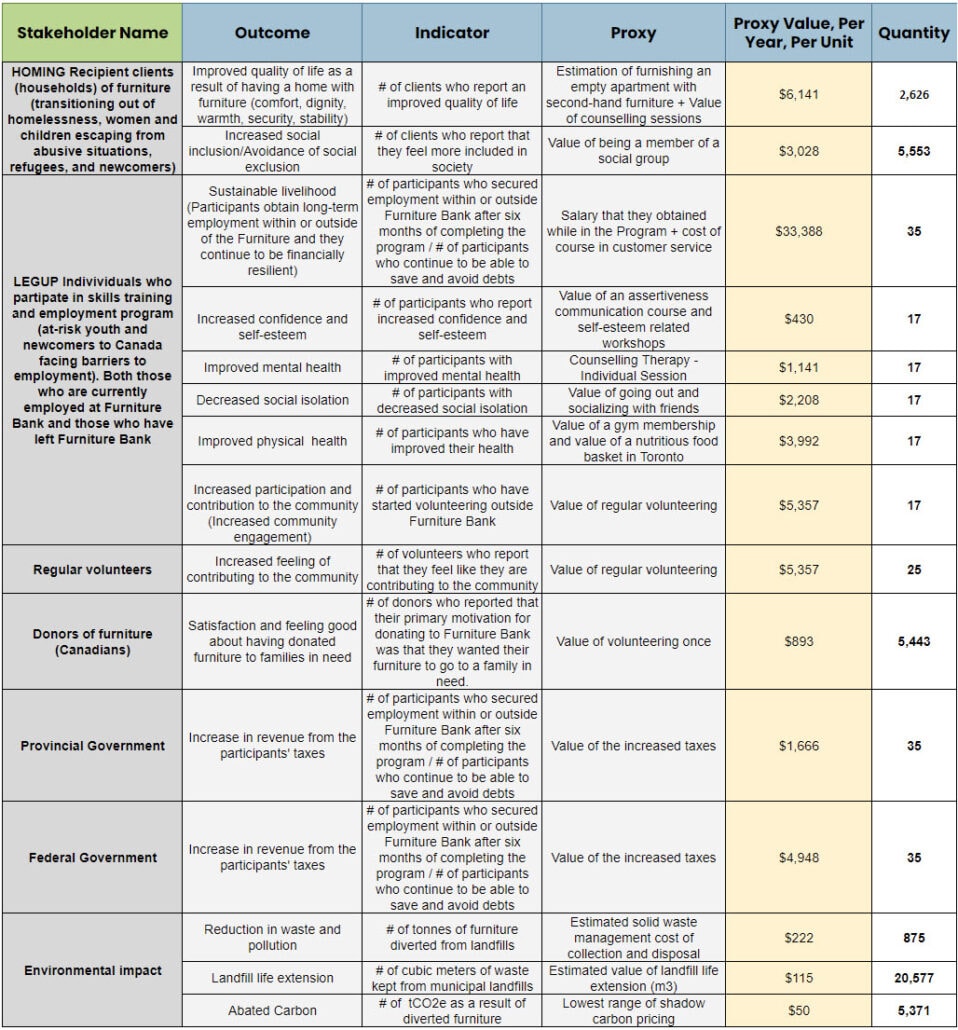
2022 SROI RESULT
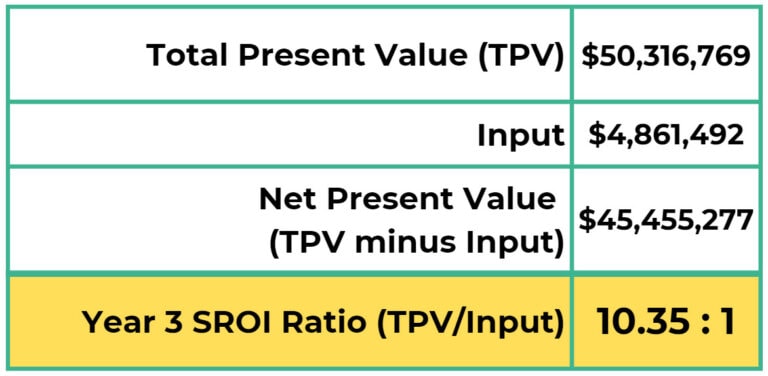
That is the equivalent to every $1 invested into Furniture Bank creates $10.35 in measurable social, environmental, and economic benefits in creating stronger communities.
Following the analysis and evaluation of the outputs, outcomes, indicators and impact, it is possible to assign financial values to the tangible impact of Furniture Bank.
Where assigning financial value against impacts has been possible, and legitimate references have been used, a triangulated approach has been adopted, i.e. government financial costs have been the primary sources, supported by academia/ social value banks and further supported by interviews and research within the relevant sector.
By combining Furniture Bank’s internal data, stakeholder interviews with open data and evaluation findings put forward, we calculated the value of Furniture Bank social impact in 2022 to be $45.5 million.
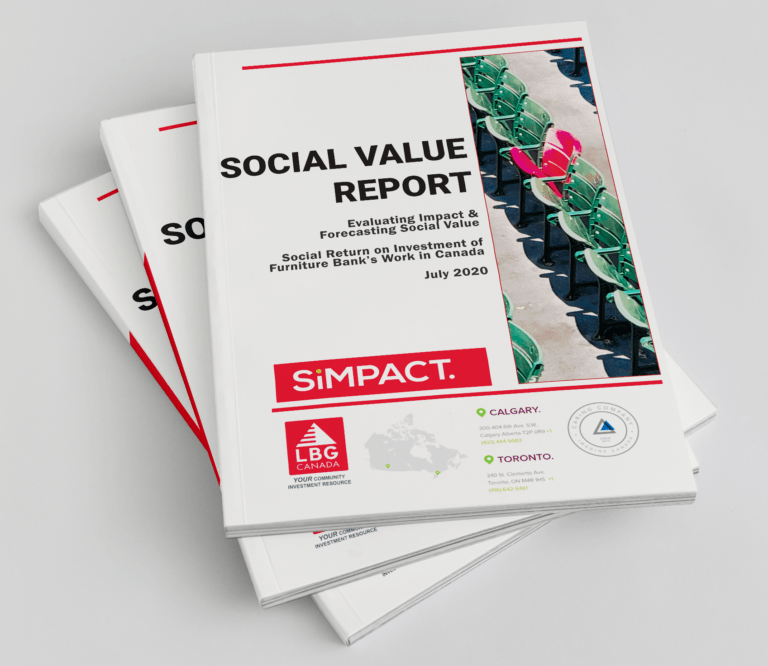
2019 Social Value Report
The Furniture Bank’s approach to measure impact and to understand the value of impact from the perspective of stakeholders (i.e. clients seeking to furnish their homes) is on the path to be ‘best in class’ because the intention is to use results to improve service delivery and client experience – i.e. to maximize impact. This is exactly the reason why understanding the value of impact can enable greater organizational success.
Our outcome goals in 2023
Furniture Bank is in an exciting and transformative period of its journey to end furniture poverty across Canada. In the GTA it continues to look for solutions to expand capacity to reach more donors and more agencies to support ultimately more families. Across Canada it is seeing momentum for other charities to align their program operations on our IT platform and processes allowing for common approach to furniture banking (and measurement).
Looking ahead to the next 12 months Furniture Bank intends to:
- Integrating other communities into the SROI model to create a national SROI result that includes all furniture banks on the FB Support Service.
- In the GTA we aim to provide Homing solutions to 4000 families who report an improved quality of life to 4,000
- We are seeking new measurement approaches to capture increases in clients feeling more included in society by 5%
- Ensure 85% of participants in the Leg Up program secure employment within or outside Furniture Bank after six months of completing the program
- Achieve an estimated carbon saving to the environment of 5,000 tCO2e by 2023
- 100% of clients report enjoying an improved quality of life through the provision of furnished homes (from empty housing).
HOW WE'RE FUNDED?
Furniture Bank is a social enterprise powered charity, funded by a mix of financial gifts and donations, corporate and civic partnerships and our own activities. The full breakdown of 2022 income and expenditures is outlined in the charts below:
2022
Revenue Sources
Source: 2022 Audited Statements, in 000’s of Cdn Dollars
Cost Areas
Source: 2022 Audited Statements, in 000’s of Cdn Dollars
Program Spending
Program spending allocated to each core program in the most recent fiscal year. Source: Internal program analysis, in 000’s of Cdn Dollars. Note Homing includes the value of donated items passed directly to families.
What we've learned
Furniture Bank continually monitors its program performance and uses data-driven insights to refine its operations leveraging Salesforce, to track hundreds of activities and outputs. Over the past two years, despite the economic headwinds, global pandemic, and a national cost of living crisis, Furniture Bank has persevered and excelled, thanks to robust social enterprise work and innovative approaches to Homing.
Furniture Bank employs a comprehensive performance tracking system that measures various metrics. Over the past two years, it successfully collected and redistributed 141,000 furniture items, serving over 14,455 individuals and 7,149 families. This demonstrates an increased capacity in managing furniture donations and a commitment to mitigating furniture poverty. These figures not only serve as tracked metrics but are invaluable indicators of program performance and impact.
Environmentally, Furniture Bank has contributed significantly to waste reduction and sustainability. The metric of waste diversion tracked over the past years highlights our environmental stewardship, as we have diverted thousands of cubic meters of furniture from landfills.
Additionally, Furniture Bank’s social enterprise initiatives, such as the Indigenous-led Workshop (part of the Leg Up Program), are tracked for their dual impact – providing job training and employment opportunities while reducing waste through furniture repair. This tracking has shown that these initiatives contribute to the economic empowerment of individuals facing barriers to employment and facilitate pathways to self-sufficiency.
Lastly, Furniture Bank’s success in securing social procurement contracts with government and businesses is tracked and analyzed, which has provided useful insights into potential growth areas.
Our data and digitized focus program operations allows us to immediately responding to performance metrics demonstrate Furniture Bank’s resilience and adaptive capacity in a rapidly changing environment. It continues to leverage this data for continuous learning and program improvements, underscoring the commitment to its mission of ending furniture poverty and promoting environmental sustainability.
What program changes have come from this learning?
One major change undertaken in the past couple years has been the development and implementation of our National Support Services (FBSS). Recognizing the potential for broader impact, Furniture Bank leveraged technology and digital innovation to develop a cost-effective platform for reuse charities across Canada. Tracked metrics indicated a significant need and potential for enhanced collaboration and shared resources among furniture banking charities. Based on this data, Furniture Bank made the strategic decision to use its expertise and infrastructure to support other organizations, thus extending its impact on a national scale.
The FBSS initiative integrates services to reduce administrative costs and offers a national impact measurement model for member charities. The program change came about as Furniture Bank identified the need to consolidate the efforts of various furniture banks and maximize efficiency. As a result, they developed a cloud-based platform to support these charities in managing their operations more effectively.
Another key program change was the strategic diversification of Furniture Bank’s income sources. Tracked metrics over the years showed a decline in traditional donations and increased economic uncertainty, indicating the need for alternative, sustainable sources of income. This led to the increased focus on securing social procurement contracts with government and businesses, which has proven successful in boosting Furniture Bank’s financial resilience and supporting its mission.
SIMCOE / BARRIE
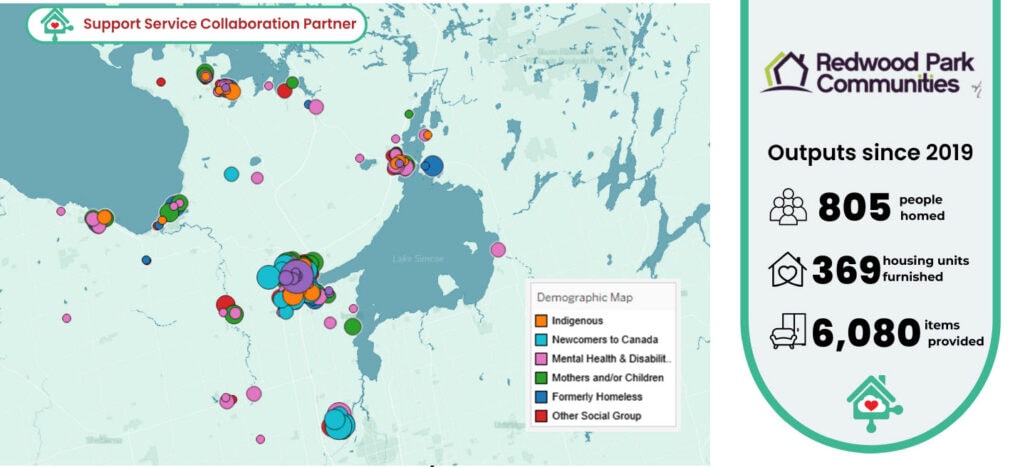
OTTAWA REGION
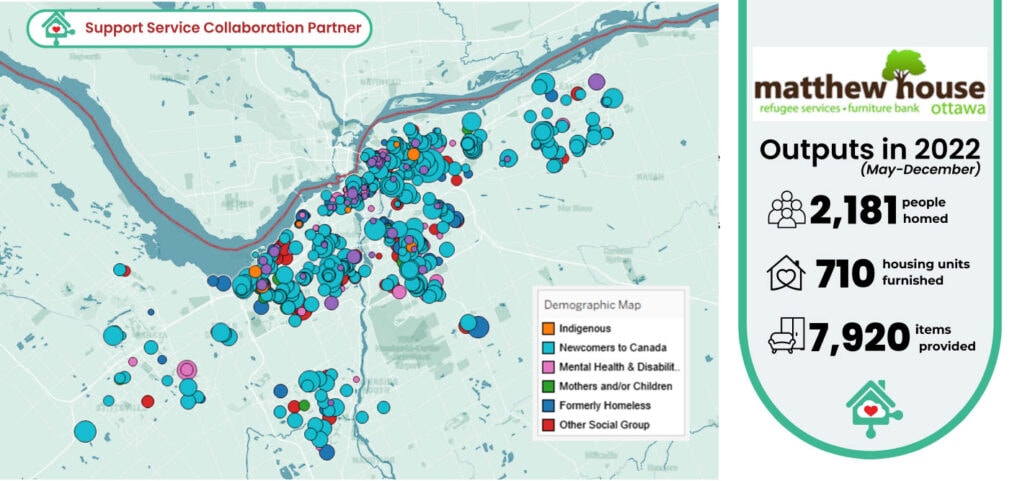
WINNIPEG
